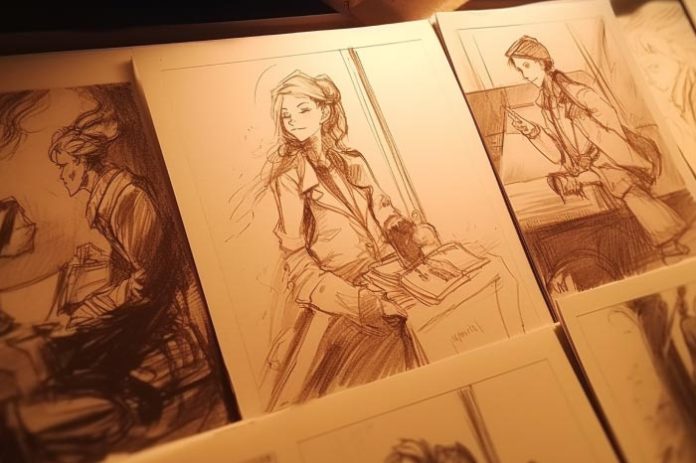Storyboarding, traditionally a staple in film and animation, has recently carved its niche in education. This transformative approach is not just a creative outlet.
It’s a robust tool for enhancing learning, comprehension, and collaboration among students. Let’s explore how this technique is reshaping the educational landscape.
The Essence of Storyboarding in Education
Let’s understand what is storyboarding for starters. Storyboarding is a method where a series of drawings or images are arranged in sequence to pre-visualize a story or concept.
Typically, each panel represents a key scene or idea, with brief descriptions or dialogues added for clarity.
This visual planning is akin to writing a graphic novel or creating a comic strip, where each panel is a step in the unfolding narrative. It’s translating thoughts and ideas into a visual format, making complex ideas more accessible and engaging.
This technique appeals particularly to visual learners in teaching, breaking down complex ideas into understandable segments. But it also offers other perks:
1. Enhancing Learning and Creativity
Storyboarding excels in fostering creative thinking and comprehension. It nudges students to visualize and present ideas in a structured format.
This is incredibly effective in subjects like film studies, where students analyze or create storyboards to understand storytelling techniques, such as camera angles and scene transitions.
Consider a history class where students storyboard a significant event. This exercise not only aids memorization but also deepens understanding of historical contexts and implications. Visualizing these events can lead to a more profound engagement with the material.
2. Collaboration and Problem-Solving
Storyboarding also facilitates collaborative learning. It encourages students to share ideas, critique each other’s work, and engage in collective problem-solving. This interaction enhances communication skills, an essential competency in the modern workforce.
3. Preparing Students for Diverse Careers
Storyboarding equips students with skills that transcend the classroom. It nurtures creativity, organization, and visual communication – abilities that are highly sought after in numerous fields, including film, advertising, marketing, and digital media.
By integrating storyboarding into the curriculum, educators prepare students for a future where these skills are increasingly crucial.
Integrating Storyboarding into the Curriculum
Storyboard is a universal tool that both teachers and students can use. Here are some examples:
- Literature and Language Arts: Use storyboards to summarize books, illustrate narrative arcs, or create visual character analyses. It can also be a tool for planning written assignments like essays or creative writing projects.
- History and Social Studies: Students can storyboard historical events, political processes, or social movements. This helps in visualizing timelines and understanding cause-and-effect relationships.
- Science: In science classes, storyboarding can illustrate scientific processes, experiments, or the life cycle of organisms. It’s a way to make abstract scientific concepts more concrete and visually engaging.
- Mathematics: Though it might seem less intuitive, storyboarding can be used to visualize problem-solving processes, and geometric concepts, or to illustrate real-world applications of mathematical principles.
4 Tools You Can Use for Storyboarding

With the rise of digital tools, storyboarding has become more accessible. There’s a bunch of tools teachers and students can use to leverage the benefits of storyboarding. Some of these tools are:
1. Storyboard That
Storyboard That is user-friendly and specifically designed for educational purposes. It offers a vast library of characters, scenes, and objects. It’s excellent for creating storyboards, comic strips, and graphic organizers.
Best For: Classroom use, especially in K-12 settings.
2. Canva
Canva is known for its ease of use and a vast array of templates, including storyboard templates. While not exclusively a storyboarding tool, it’s versatile and allows for creative freedom.
Best For: Teachers and students who also need a tool for other graphic design projects.
3. Boards
Boards is a straightforward tool that offers features like script editing, animatics, and online sharing. However, it’s more suited for professional storyboarding needs.
Best For: Professional settings or higher education where detailed storyboarding is required.
4. Plot
Plot offers a clean interface and straightforward storyboarding capabilities. It’s great for quickly creating basic storyboards.
Best For: Users who need a simple, no-frills approach to storyboarding.
Bottom Line
Storyboarding in education is not just a trend; it’s a paradigm shift towards a more interactive, engaging, and effective learning experience. It encourages students to think visually, work collaboratively, and approach problems creatively.
As we embrace innovative teaching methods, storyboarding stands out as a powerful tool in cultivating the next generation of thinkers, creators, and problem solvers.
This visual journey in classrooms paves the way for students to become more adept, imaginative, and prepared for the challenges of the future.





